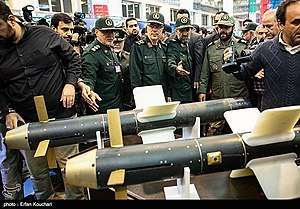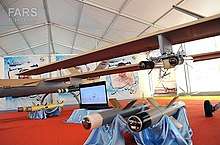Sadid-345
The Sadid-345,[1] also known simply as the Sadid guided bomb[2] is an Iranian precision-guided glide bomb with a fragmentation warhead.
| Sadid guided bomb | |
|---|---|
 | |
| Place of origin | Iran |
| Specifications | |
| Mass | 34 kg (75 lb) |
| Length | 169 cm (67 in) |
| Width | 152 mm (6.0 in) |
The Sadid-345 is meant for use on UCAVs.[2] Its main launch platform is the Shahed 129.
Specifications

The bomb weighs 34 kg and is 1.63 meters long, with a diameter of 152 mm.[2] It has four fixed fins on the body for lift and stability and four deflectable fins on the tail for trajectory control.[3] The bomb has a range of 6 km[1] and is made of composite material.[3]
The Sadid-345 warhead is filled with composition H6 explosive and is prefragmented, with a specified lethal radius of 30 m.[2] It is detonated by an impact fuse.[2]
There is the possibility that Sadid-345 glide bombs could be developed with tandem-warheads, but as of the present there is no evidence of this.[4]
The Sadid-345 can be equipped with an infrared seeker, with CEP of 2.5 meters, a laser seeker with a CEP of 2.5 m, or a visual light seeker with a CEP of 5 m (though the CEP may be larger if there is difficulty with the image processing).[2]
Operational history

Development
The Sadid-345 was developed after the intended armament for Iran's Shahed 129 UAV, the Sadid-1 ATGM, could not be successfully integrated for unclear reasons.
It is believed the Sadid-345 was developed from the Toophan through removal of the engine, propulsion system, and wire guidance components.[4]
Use
The IRGC is the only purchaser of the Sadid-345, as of 2018.[4] "Tens" of Sadid-345 bombs have been dropped on the Islamic State in Syria by Shahed 129s.[5]
It can also be integrated on HESA Shahed 285 attack helicopters.[4]
Operators
Launch platforms
References
- "Iran unveils production line of Sadid-345 smart bomb system – Defence Blog". defence-blog.com. 29 June 2017.
- Lyamin, Yuri (20 July 2017). "Иранская экспозиция на МАКС-2017. Часть.1" (in Russian).
- Vladimir Karnozov (July 27, 2017). "Iranian Weapons and UAVs On Display at MAKS". Aviation International News.
- "معرفی بمب هوشمند و هدایت شونده سدید ۳۴۲ و سدید ۳۶۱ - -مرجع آخرین اخبار نظامی,دفاعی و امنیتی ایران و جهان-". www.militarynews.ir (in Persian). 30 January 2018.
- "Babak Taghvaee on Twitter". Twitter.